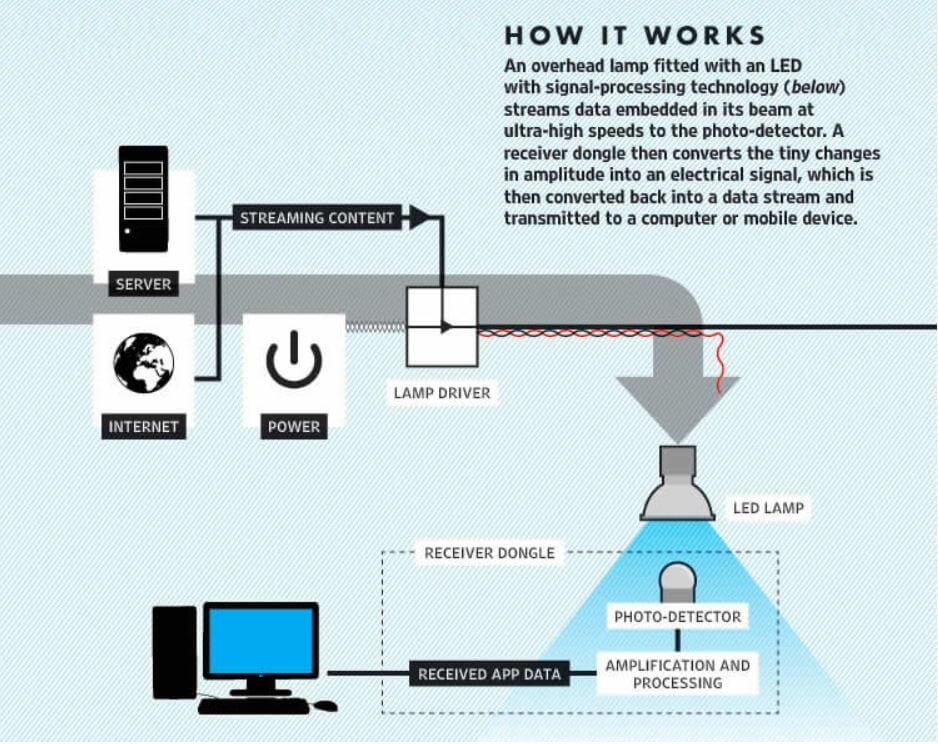A Technology faster than Wi-Fi? Who would have thought about ‘Li-Fi’?
“Li-Fi is a next-gen wireless connection that uses light as a medium to transfer data, instead of the current microwaves. The technology is said to be 100 times faster than WiFi!!!”
Considering that the corporate era is backed by technology, especially ‘internet’, it would not be wrong to consider Wi-Fi somewhat like ‘Oxygen’. Wi-Fi is what’s allowing us to stay updated in a world which has everyone interconnected by data, which today allow us to do things that were not possible a few years back.
It was in the year 2011, Professor Harald Haas from the University of Edinburgh coined the term ‘Li-Fi’.
And now, we have ‘Li-Fi’ soon about to make a full-fledged debut that will put Wi-Fi in the backseat and may soon take over as the new internet connection system. Yes, Wi-Fi will not disappear but will merely be shifted to a background role in favour of much better technology.
What is Li-Fi Technology?
As quoted at the beginning of this blog, Li-Fi (namely ‘Light Fidelity’) is a wireless network that uses light sources instead of the current microwaves to transfer data. Imagine your regular LED bulb acting as a router at your home or office. Of course, you will need a ‘transmitter modulator’ to jump-start the process.
If current research is to be believed, then Li-Fi will be 100 times faster than Wi-Fi.
Here’s what you can expect of Li-Fi:
Speed
LiFi is believed to provide a speed up to 100 Gbps, whereas the maximum-recorded speed goes up to 224 Gbps.
Secure
Li-Fi operates under a condition that a system has to be in contact with LED light beam emitter, which strengthens security. Furthermore, only those devices that are illuminated by the same emitter will be able to connect with other devices, which reduces (if not eliminates) the risk of unauthorized access and cyber-attacks.
Safe
Unlike Radio waves/frequencies, light is relatively safer to human beings and nature.
No Congestion
Since the spectrum of light is 1000 times more than the radio spectrum, the signal is free of electromagnetic interference.
Higher efficiency with lower cost
The successful implementation of Li-Fi at workplaces and at homes will save costs by eliminating the need of electronic devices such as routers, modems, signal repeaters, antennas, wave amplifiers and many more devices that support the current data transmission system. Other than the purchasing aspect, these devices at the moment need electricity to operate 24 X 7, which will be saved once Li-Fi is implemented at a larger scale.
In future, if we are to use solar energy for data transmission then this technology will enable internet access to people with limited electrical resources as well.
Since we have a more viable and efficient solution in the form of Li-Fi, it is imminent that the technology will push Wi-Fi to the backseat. If you imagine a future, in which everyone uses LED bulbs and Li-Fi is built into them all – desk lights, industrial lighting, streetlights, vehicle lights – you can see how it could easily be widely available in ways that WiFi cannot match.
Tell us your opinion in the ‘comment’ section and if you liked this blog then give us a ‘thumbs up’ and don’t forget to ‘share’.
















 P.O Box :
P.O Box : 

 2023 UNION COOP. All Rights Reserved
2023 UNION COOP. All Rights Reserved



Leave Comment